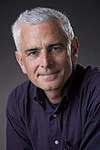High five from P5
 |
|
Craig Hogan
|
Craig Hogan, head of the Center for Particle Astrophysics, wrote this column.
To a physicist, the entire expanding universe is a unique measurement apparatus ideally suited to explore some of the deepest mysteries of physics. Its large-scale structure and evolution is dominated by the gravity of exotic dark matter and dark energy and detectably influenced by the gravity of neutrinos; its contents experience far more extreme conditions than any material we can create on Earth, even in the largest accelerators; and it is so simple on large scales that comparisons with theory can be made with high precision.
Indeed, the recent strategic report of the Particle Physics Project Prioritization Panel proposes cosmic experiments to engage all but the first of their five intertwined "scientific drivers:"
- Use the Higgs boson as a new tool for discovery.
- Pursue the new physics associated with neutrino mass.
- Identify the new physics of dark matter.
- Understand cosmic acceleration: dark energy and inflation.
- Explore the unknown: new particles, interactions and physical principles.
There are a billion times more neutrinos in the universe than other matter particles; their cumulative gravity in large cosmic systems probably exceeds that of stars. We can measure their mass with a combination of future cosmic surveys and cosmic microwave background experiments that also probe cosmic acceleration.
The new physics of dark matter is probed with a set of experiments that aim to detect directly rare collisions of dark matter particles that make up the halo of our galaxy with atomic nuclei in very sensitive, deep underground detectors. Soon, a next-generation set of experiments will be chosen to challenge theoretical predictions for their abundance and interactions.
We seek to understand cosmic acceleration using various types of deep, wide surveys of the universe. The Dark Energy Survey and future surveys (DESI and LSST) use optical imaging and spectroscopy to measure positions and motions of objects such as supernovae, galaxies, intergalactic gas (via its effect on quasar light) and galaxy clusters, which map the geometry of space-time and its response to the dark energy that causes cosmic acceleration.
Next-generation studies of the cosmic microwave background (SPT-3G and CMB-S4) will map the polarization of the primordial background light in great depth and detail. They will not only help optical surveys to constrain models of dark energy in the universe today, but also uniquely probe the early-universe acceleration called inflation, as well as possible new forms of "dark radiation" that could have contributed to early expansion, and the sum of neutrino masses influencing large scale structures.
A unique probe of the quantum nature of space-time, the Fermilab Holometer, will soon constrain or uncover evidence for new physical principles governing the unification of matter and space-time at the Planck scale. We also pursue R&D on new detector technologies that may find application across a wide range of experiments.
The compelling case in the new report will help propel this exciting program forward. Along with our partners at labs and universities across the country, we look forward to making it a reality.
|